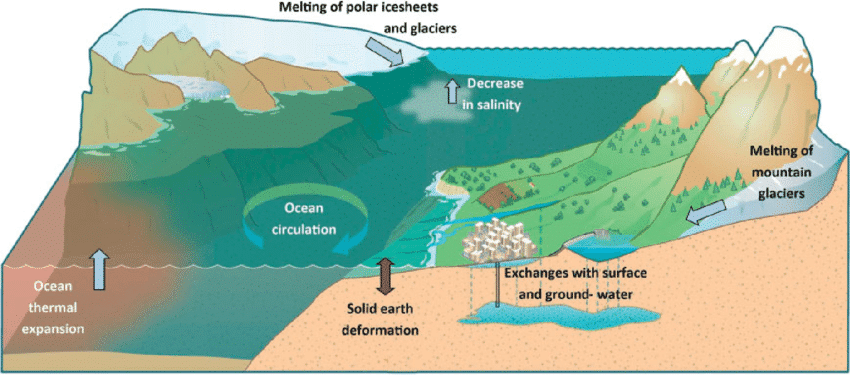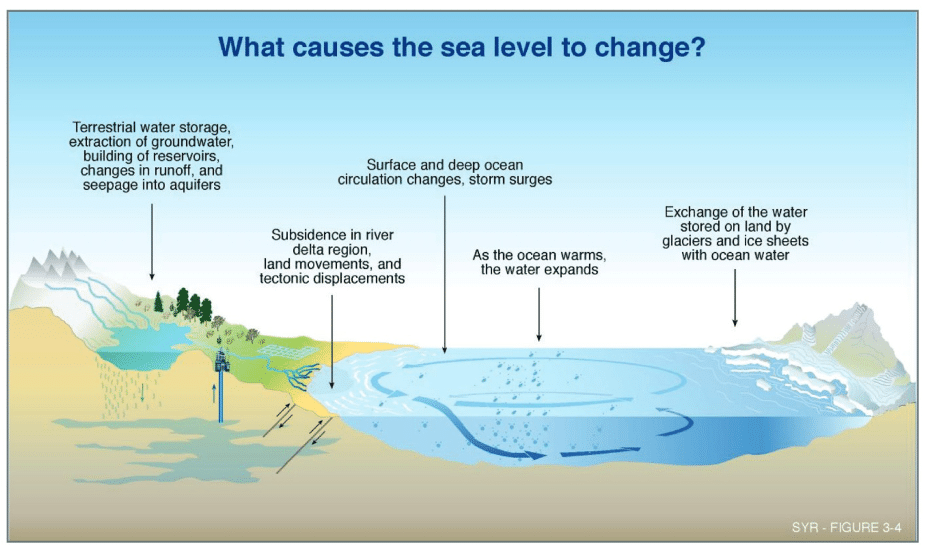- By changes in sea level, we mean the fluctuations in the mean sea level, i.e., the average level of the sea surface. Thus, the changes in sea level may also be termed as a relative change in sea level.
- During the relative rise in sea level, either the land or the sea surface may undergo upliftment or subsidence, or both may rise and fall at the same time.

The Major Categories of Change in Sea Level are Mentioned Below
- Eustatic changes occur when the volume of seawater changes due to factors such as global warming and melting of ice sheets (rise in sea level) or ice ages (fall in sea level).
- Tectonic changes occur due to a change in the level of the land. These changes occur due to the following factors:
- (a) Isostatic changes which take place due to addition or removal of load, e.g., during ice ages, landmass subsided due to the tremendous load exerted by the glacial ice; as a result, there was an apparent rise in sea level. On the other hand, the landmass of Scandinavia is still rising as the glacial ice is being removed
- (b) Epeirogenic movement occurs due to broad-scale tilting of continents which may result in the rise of one part of the continent in relation to the mean sea level even as the other part may subside causing an apparent rise in sea level.
- (c) Orogenic movement is related to folding and flexuring (stretching of a part of the earth’s crust) of the lithosphere which results in the formation of lofty mountains and an apparent fall in sea level.
Relevance of the study of sea-level changes
- The study of sea-level changes is important. It provides key evidence regarding climate change and also enables us to draw a benchmark for estimating the rates of tectonic upliftment in the past geological periods.
- Sea level directly influences the rate and pattern of erosional and depositional processes in the coastal areas.
- By studying the fluctuations of sea level it becomes possible to assess the suitability of coastal locations for industrial development.
- The fluctuations in sea level determine the availability of land, particularly in coastal areas, which are important for agricultural purposes.
- The submergence of land in the future could be a disaster for human civilization as it may endanger our food security.
- By predicting climate change and the possible areas to be submerged undersea, it becomes possible for the low-lying countries to build coastal dykes and embankments.
- The task of mapping of areas likely to be affected by storm surges and periodic flooding becomes possible only if we know the likely areas to be affected by future sea-level rise. The construction of tidal power generation units needs suitable locations.
- By identifying the areas of possible submergence in the near future it becomes possible for us to set up tidal power generation plants in suitable locations.
Mechanisms of the change in sea-level
- The fluctuations of sea level involve three basic mechanisms:
- changes in ocean water volume;
- changes in ocean basin volume;
- changes in the geoid, i.e., the shape of the earth changes in the volume of ocean water:
- The present sea level would rise by about 60 to 75 m if the ice in Antarctica melts, whereas the Greenland ice cap would contribute about 5 m rise in sea level.
- It is assumed that, in such a case, the added load of ocean water would lead to the sinking of the ocean floor due to isostatic compensation.
- So the total rise of sea level would be about 40-50 m. However, the isostatic adjustment of the land and the ocean is still not clear due to a lack of data.

Changes in the volume of the ocean basin
Changes in the volume of the ocean basins and the resultant changes in sea level were an important event of the Mesozoic Era and the early Cenozoic Era.
Such changes occur due to the following factors:
- Changes in the volume of mid-oceanic ridges: An important tectonic cause of the sea-level rise, changes in the volume of mid-oceanic ridges may occur due to periodic reorganization of plate boundaries which cause variations in the total length of the ridge system. If the lithosphere is warm, the spreading rate increases causing an increase in ridge volume and vice versa. The sea level rises when the oceanic ridge increases in volume.
- Accumulation of sediments on the ocean floor: Sediments are produced by the denudation of continents and are deposited on the ocean floor. The deposition of sediments may result in the subsidence of the ocean floor and the removal of sediments either through subduction or upliftment. If we do not take these two factors into consideration, there will be a rise in sea level due to the decreased volume of the ocean basin.
- Impact of orogenesis: As orogenesis causes shortening and thickening of continental crust and a reduction in the area of continents, the sea level falls as a result of an increase in the volume of the ocean basin.
Short-Term Changes in Global Sea Level:
- Short-term changes occur during a year. Commonly, seasonal variations of 5-6 cm in sea level are observed in a year. But the fluctuations of sea level reach 20-30 cm or more in almost all coastal areas of the world. Even if the causes of such short-term changes are not known, the fluctuations of sea level may be due to a complex interaction of the following factors:
- Marine water density: Temperature and salinity control the density of seawater. Low temperature and high salinity produce a high density of seawater and lower sea level. It is due to a lower temperature and higher salinity that the eastern part of the Pacific Ocean has a sea level30-50 cm higher than the Atlantic Ocean.
- Atmospheric pressure: Low-pressure results in higher local sea level and vice versa. The sea level rises locally in places of low pressure because water is sucked in by the upward moving air mass.
- Velocity of ocean currents: Fast-flowing ocean currents when taking a curved path cause a rise in sea level on their outer fringes.
- Ice formation and fall in sea level: During winter the ocean water trapped in the icecaps of the northern and the southern hemispheres leads to a fall in sea level.
- Piling up of water along windward coasts: A local rise of sea level occurs in the coastal region as water is driven towards the coasts by an air mass, for example, the sea level rises in the south and East Asia during the monsoon months due to landward movement of the air mass. The twentieth century has observed short-term global sea-level rise due to the following factors. Global warming in the last century due to anthropogenic activities have resulted in the thermal expansion of ocean water.
Impact of the sea-level fall – changes in the base level of rivers, rejuvenated landforms, extended shoreline, lengthening of rivers, death of coral reefs, the extension of ice caps.

very helpful….thank you..
Thanx really appreciable
Thanks.